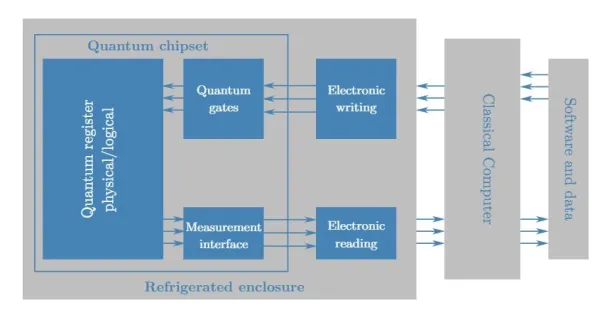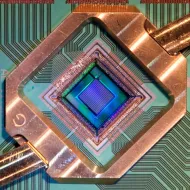Tech giants are spending millions in USD to advance the QC industry. We’ve explained how quantum computers work and the underlying quantum principles that make them stronger than conventional computers.
Learn about the current state of quantum hardware and its commercial readiness:
Quantum computing components

In classical computers, bits, registers, and logic gates are the building blocks of the hardware. In quantum computers it is qubits, quantum registers, and reversible gates. The names may sound similar but the concept is different. Starting from the smallest components to higher level systems, quantum computers are made up of:
Qubits
Qubits are the basic units of the quantum memory which, in contrast to classical bits that can be either 0 or 1, can hold both 0 and 1 state thanks to superposition. For example, 8 classical bits are enough to represent any number between 0 and 255. On the other hand 8 qubits can represent all numbers between 0 and 255 at the same time.
There are different approaches with different pros & cons to simulate qubits. These include:
Photonics
Photons have a natural isolation property due to their weak interactions with the surrounding environment, which makes them a great candidate to carry information, represent qubits, and operate at room temperature. Another advantage is that photonic quantum computers can be integrated into existing fiber optic-based telecommunications infrastructure.
However, one of the challenges that face photonic quantum computing is the limitations in fault tolerance and error correction.
Current companies developing photonic quantum computing technology include PsiQuantum, Xanadu, and the Amazon Quantum Solutions Lab.
Trapped ions
Quantum hardware that uses trapped ion qubits typically rely upon microwave or optical signals transmitted through free space or waveguides and delivered to the location of the qubits. Current QC prototypes of trapped-ion consist of a chain of 5 to 20 static ions in a single potential well. Challenges that face trapped-ion systems are:
- the difficulty of isolating individual ion motions as chain length increases
- the number of ions one can individually address with gate laser beams
- measuring individual qubits
Current companies that work on ion-trapped quantum technologies include Honeywell and IonQ,
Semiconducting material
Qubits can be simulated by manipulating individual electrons in semiconducting materials such as selenium or germanium, or defected materials such as diamonds, aluminum nitride or silicon carbide. Applying microwaves and magnetic fields to these materials will allow them to exhibit superposition, entanglement, and other quantum properties.
Companies that rely on semiconducting technology for their QCs include Intel, Google, and IBM
Superconducting material
Superconducting qubit systems are controlled using microwave and low-frequency electrical signals, both of which are communicated through wires that run into cooling refrigerators to reach the qubits inside the controlled environment. In 2018, Intel announced the construction of a 49 qubit superconducting chip called Tangle Lake.
Quantum registers
A quantum register is a set of qubits, and it holds all possible configurations of input data at the same time. In other words, applying a quantum algorithm to an n-qubit register will get the QC to compute all possible 2^n combinations of 0/1 states “in parallel”.
Quantum reversible gates
A reversible gate is the one whose input can be reconstructed just by looking at the output. For example, in classical computation the NOT inverter gate is reversible, whereas the XOR gate is irreversible because inputs cannot be identified by looking at the output. It is necessary for quantum gates to be reversible because quantum mechanics is reversible and quantum operations are unitary. Unitary operations are such that their inverses are also their conjugates.
Logical reversibility allows for:
- Reversing quantum circuits: by applying the sequence of ’inverse’ quantum gates in reverse order to the output.
- Reducing computational power: since each input is associated with a unique output, no qubit can be erased. Therefore, no energy would be lost during computation.
Quantum processing unit
A quantum processing unit (QPU) is a computational unit that relies on quantum principles to perform a task. the QPU includes the:
- QRAM (register + gates)
- Quantum control unit (QCU) which drives the system to the desired state.
- Classical controller interface which defines the interaction between the host CPU and the QPU
How does a developer interact with the quantum computer?
To program a quantum computer, the programmer will send the algorithms via a host system, typically called “host processor”. A host processor is a classical computer which has a high bandwidth connection to the QCU. The host runs a conventional operating system to allow the user interaction with the quantum processor.
To learn more about programming quantum computers, feel free to read our article Quantum programming: Languages, SDKs, & Algorithms.
Challenges that quantum hardware faces
Isolation
The most common challenge is isolation. Heat and light can cause quantum decoherence, where qubits lose their quantum properties (superposition and entanglement), as well as the information they store. Typically, quantum computers are stored at ~0 Kelvin (−273.15 Celsius).
Signal control
To change the state of a qubit, it needs to be rotated (flipped by the logic gate). These rotations are prone to error. For instance, if an algorithm requires a number of qubits to be rotated by 90 degrees but an error causes a rotation by 90.1 degrees, the accumulation of qubits rotating at this rate of error will result in an incorrect output.
Quantum error correction QEC approaches
Quantum error correction (QEC) is necessary to protect quantum information from errors due to decoherence and other quantum noise. In classical computers, error correction employs redundancy which means copying and storing the bits used to encode a given amount of information many times and checking whether they are the same. If changes are found then the majority of identical information is the true version.
However, quantum information cannot be copied due to the no-cloning theory which states that it is impossible to create an identical copy of an arbitrary quantum state. Another challenge that faces quantum error correction is the problem of wavefunction collapse.
In a classical computing, arbitrary properties can be measured without compromising the encoded information. In quantum computing, measuring qubits as a part of the error correction procedure must be carefully done in order not to cause the wavefunction to collapse and erase the encoded information.
Real-life example: Google announced their quantum chip Willow, which achieved a significant breakthrough in quantum error correction. Unlike traditional quantum systems where errors typically accumulate with additional qubits, Willow demonstrated the ability to reduce errors exponentially as the system scaled up.
While testing progressively larger arrays from 3×3 to 5×5 to 7×7 encoded qubits, each scaling step cut the error rate in half. This achievement, known as operating ‘below threshold,’ represents the first convincing demonstration of real-time quantum error correction in a superconducting system since the concept was introduced by Peter Shor in 1995.1
For more on quantum computing
Now that you’ve read about quantum hardware, you maybe interested in:
- Quantum software
- QC use cases in business and technology
- Quantum computer companies that build quantum hardware
You can also check our sortable/filterable top quantum computing companies list.
If you are ready to be a part of the quantum computing future, let us guide you:


Comments
Your email address will not be published. All fields are required.